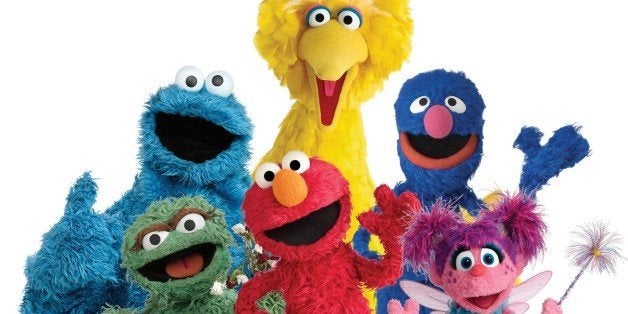
I was walking to Penn Station in New York a couple of weeks ago when an enormous billboard caught my eye. "The new season of Sesame Street, Brought to you by the Letters H,B,O" it screamed. Elmo, Big Bird and Cookie Monster stood in the foreground holding up the acronym for Sesame's new home station - the "O," held by that loveable furry blue monster, predictably a little nibbled at its edges.
It's true - now the way you get to first-run Sesame Street is by watching it on a premium cable channel. What might this mean for one of the longest-running, most-awarded educational children's programs and its prime mission of bringing its lessons to all children regardless of background?
There's been a lot of hype about Sesame's move to HBO. Much of it has been about the business side of the equation, and some of it has been about the changes in format. When the deal between Sesame and HBO was announced in August 2015, Austin Siegemund-Broka in the Hollywood Reporter proclaimed it "a lifeline for Sesame Workshop, the nonprofit that produces the show." Sesame Workshop had been operating at a considerable deficit for a number of years, and an infusion of funds from HBO in the five- year deal will allow creators to produce twice as much content and a new Muppets spinoff.
At one time Sesame generated much revenue from DVD sales and licensing agreements with toy, game and publishing companies (remember the Tickle Me Elmo craze?) But profits from these sources have waned as kids watch tv through other platforms, toy tastes have shifted and there's simply more children's media content around to compete.
When the new season kicked off this past Saturday, viewers saw many changes. The show has shrunk from an hour to half an hour. There are new characters, a new set and even a new theme song.
Some have wondered whether the move to HBO will mean other changes for Sesame Street, too. After all, this iconic show, brainchild of public television producer Joan Ganz Cooney and Carnegie Corporation vice-president Lloyd Morrisett, was conceived amidst the social turmoil of the 1960s. When it first aired in 1969, its mission was to bring quality educational programming to preschoolers of all backgrounds. But some of the foundations providing financial support for Sesame Street's development were especially interested in the question of whether the first children's television show with a research-based curriculum and terrific production values, could be especially beneficial to children in under-resourced communities.
In the early days of Sesame Street, Gerry Lesser, the Harvard professor brought on as chief adviser, pondered whether the show could level the educational playing field for what he termed "advantaged and disadvantaged" children. In his 1974 book, Children and Television: Lessons from Sesame Street, he wrote that before researchers could tackle that question, there was "the serious question of how effective Sesame Street is especially in its efforts to appeal to inner-city children and to collaborate with parents and community organizations in the inner cities."
The team at Children's Television Workshop (later Sesame Workshop) set out to build an inner city audience. They partnered with public broadcast stations, community organizations, schools and local adolescents to get out into the streets, disseminate materials, generate conversations and get the word out. They made a huge push to get people to watch this new show on public television, which was not as widely available as it is today and certainly not as widely viewed.
And it worked. Inner city viewership in East Harlem NY, Washington D.C., Chicago and Philadelphia rose significantly in the first four years that Sesame Street was on the air. Since that time, in its 45 seasons, Sesame Street has made efforts to reach out to underserved communities not only through its educational materials and publicity, but also through its curriculum and multicultural cast of humans and Muppets.
Thousands of studies conducted in the U.S. and many other countries (versions of Sesame are also produced in many countries and the show can be seen in over a hundred nations around the world) have found much about this program's efficacy and influence. Many studies have concluded that children who are frequent viewers of Sesame Street do demonstrate certain knowledge (like recognition of letters and numbers) that children of the same age who are not frequent viewers do not.
But with Sesame's move to HBO, a premium cable channel, some critics have wondered if the show has strayed too far from its early roots. In an interview on the PBS Newshour, Judy Woodruff questioned former Sesame Workshop CEO, Gary Knell. "But what about those kids who may not have access ...to pay cable?" Woodruff asked. "Yes, they will be able to see it nine months later. But it's almost as if -- are you creating two different classes of programming for children?"
Knell responded that he felt that Sesame Workshop was not abandoning its mission; that in fact, they were responding to the reality all television content is now seen on different platforms. New Sesame Street episodes will be aired on PBS for free several months after they air on HBO. "That's why public television is important, because it creates equity, it creates access," said Knell.
Jennifer Kotler Clarke, vice president for research and evaluation at Sesame Workshop, believes that the move to HBO has not and will not change the show's central mission. She told me that they will strive "to provide a cohesive meaningful learning context, each show will address school readiness curriculum goals as they pertain to a child relevant topic. Our goal is to be more focused around themes to reduce cognitive overload --and that was decided before the partnership with HBO."
Kotler Clarke also believes that Sesame Workshop's commitment to producing a strong and research-based curriculum for the show will remain unchanged. "Our scientific methods and the populations we focus on re: research effectiveness will not change. We always include children across a range of SES/demographic circumstances in our studies." She concluded, "For my team, it is a very exciting time and I'm getting to do even more and better research!"
It remains to be seen just how Sesame's move to HBO and its stable funding base will provide new opportunities for the creative and research teams at Sesame Workshop. It's clear that partnerships between public broadcasting and commercial venues have enormous potential. And let's hope for Cookie Monster's sake that HBO's "O" is really tasty!
